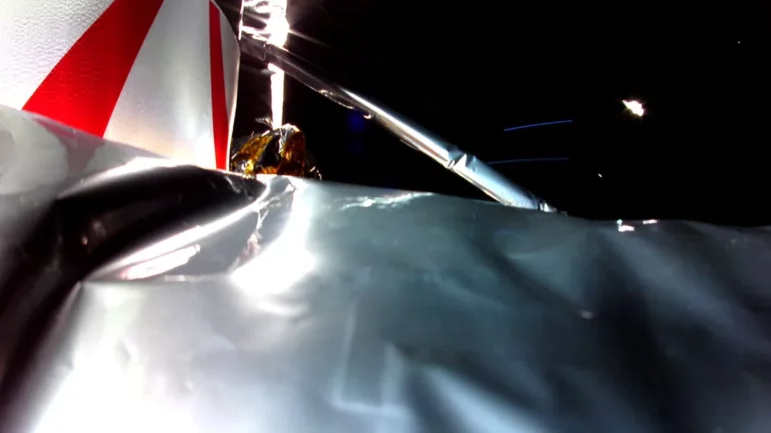Editorial Note: The Navajo people refer to themselves as “Diné”. However, the nation currently retains the name Navajo Nation.
TWH – Last week, NASA revealed that the Biden Administration had received concerns regarding the inclusion of a memorial capsule on the Peregrine lander. The presence of the capsule, which contains cremated human remains, sparked objections from the Navajo Nation. Executive Order 13175 of November 6, 2000, the Jan. 26, 2021, Memorandum on Tribal Consultation and Strengthening Nation-to-Nation Relationships, and the Memorandum of Understanding Regarding Interagency Coordination and Collaboration for the Protection of Indigenous Sacred Sites signed in November 2021 promised consultation on matters that impact tribes.
Depositing those human remains on the Moon is seen as desecrating a body considered sacred by many Indigenous peoples. The Peregrine would be engaging in this act.
In a letter dated December 21, 2023, addressed to Transportation Dept. Secretary Pete Buttigieg, NASA Administrator Bill Nelson, and Transportation Assistant Secretary for Tribal Government Affairs Arlando Teller, President Nygren expressed the nation’s “deep concern and profound disappointment regarding a matter of utmost importance.”

President Buu Nygren of the Navajo Nation [via The Navajo Nation, Office of the President]
“We believe that both NASA and the USDOT should have engaged in consultation with us before agreeing to contract with a company that transports human remains to the Moon or authorizing a launch carrying such payloads,” he wrote.
He said the current situation “echoes back to the late 1990s, when the National Aeronautics and Space Administration sent the Lunar Prospector, carrying the remains of (former astronaut) Eugene Shoemaker, to the Moon.”
“At the time, Navajo Nation President Albert Hale voiced our objections regarding this action. In response, NASA issued a formal apology and promised consultation with tribes before authorizing any further missions carrying human remains to the Moon,” President Nygren wrote.
“It is crucial to emphasize that the Moon holds a sacred position in many Indigenous cultures, including ours,” President Nygren continued. “We view it as a part of our spiritual heritage, an object of reverence and respect. The act of depositing human remains and other materials, which could be perceived as discards in any other location, on the Moon is tantamount to desecration of this sacred space.”
In a Facebook address primarily spoken in Navajo, Nygren expressed concern over NASA’s attempt to send human remains to the Moon, citing the sacredness of the Moon in Navajo culture. “Navajo people hold the Moon in such high sacredness and also respect that humans, animals, and insects and fish and all plants come from the Earth and they should be returned to the Earth.”
Peregrine was launched from the Kennedy Space Center in Florida. It is not a NASA project nor a government launch but a commercial venture by Astrobotic, an American private company focused on space robotics technology for lunar and planetary missions. Celestis and Elysium Space are companies specializing in memorializing individuals by sending their cremated remains or DNA into space. Each company had payloads on Astrobotic’s Peregrine Lander.
Celestis CEO Charles Chafer defended the mission, stating that no one owns the Moon, and religion should not inform space activities. “Nobody owns the Moon” and there is “no religious test for the conduct of space activities,” Chafer objected. He noted that while he has profound respect for the Navajo people and their culture, objecting to a space mission on religious grounds has no substance in law. Astrobotic passed the FAA/AST payload review process and “no one’s going to open the Astrobotic Peregrine lander” at this point. “We’re well founded in what we’re doing.” He said there was a public comment period when the launch license was under review where the Navajo could have raised their concerns. “We know they’ve been tracking it for at least 20 years.”
“We reject the whole premise that this is somehow desecration. We handle these capsules reverently. We do not scatter them on the lunar surface. We object to the entire characterization of our service that I read in the letter. It’s the antithesis of desecration. It’s a celebration.”
Despite the Navajo objection, the Peregrine spacecraft was launched from Florida yesterday at 2:18 a.m. Eastern time, and fifty minutes into the mission, it was effectively set on its trajectory along a highly elliptical Earth orbit. All systems onboard were successfully activated.

Technology, the creator of the Peregrine lunar lander, unveiled the initial image of the spacecraft in space on January 8, 2024. The photo, taken by a camera installed on the payload deck, reveals the Multi-Layer Insulation (MLI) on the Peregrine lander’s exterior in the foreground. Via Astrobotic/X
Shortly thereafter, officials declared that the spacecraft was in a precarious situation. The Peregrine faced difficulty positioning itself to face the sun, likely due to a propulsion issue, as reported by the company. This misalignment hindered the spacecraft from charging its batteries. Astrobotic Technology, the company that developed the first lunar lander to launch from the United States in five decades, said its spacecraft has suffered “critical” propellant loss attempting to correct itself after running into a major issue in space.
“Unfortunately, it appears the failure within the propulsion system is causing a critical loss of propellant. The team is working to try and stabilize this loss, but given the situation, we have prioritized maximizing the science and data we can capture. We are currently assessing what alternative mission profiles may be feasible at this time,” Pittsburgh-based Astrobotic wrote today in an update on X (formerly known as Twitter).
“Each success and setback are opportunities to learn and grow,” Joel Kearns, deputy associate administrator for exploration at NASA’s Science Mission Directorate in Washington, said in an emailed statement today. “We will use this lesson to propel our efforts to advance science, exploration and commercial development of the moon.”
The battery issue was later resolved, but Astrobotic was not able to correct the apparent issue with the Peregrine lander’s propulsion system. “The team is working to try and stabilize the loss, but given the situation, we have prioritized maximizing the science and data we can capture,” Astrobotic said in a statement. “We are currently assessing what alternative mission profiles may be feasible at this time.”
An improvised maneuver succeeded in reorienting the solar panels back toward the sun, allowing the battery to charge.
“The team’s improvised maneuver was successful in reorienting Peregrine’s solar array towards the Sun. We are now charging the battery,” the company said in an update posted at 12:34 p.m. ET.
However, the loss of propellant meant the moon-landing objective could not be achieved. Astrobotic stated that it must correct the underlying propulsion issue. The spacecraft would need to use its onboard thrusters — and have enough propellant left over — to make a soft touchdown on the moon.
“It’s certainly going to have some impact on our relationships and our ability to secure additional missions in the future,” Astrobotic CEO John Thornton said. “It certainly wouldn’t be the end of the business, but it would certainly be challenging.”
In its update posted just after 4 p.m. ET Monday, Astrobotic added that its Peregrine team has “been awake and working diligently for more than 24 hours.”
“We ask for your patience as we reassess incoming data so we can provide ongoing updates later this evening,” the statement reads.
Peregrine is named after the world’s fastest animal. The name is derived from the Latin word “peregrinus,” which means “foreign” or “from abroad” and shares its roots with the word “pilgrim” which refers to someone who travels to a sacred place for religious reasons, often undertaking a journey for spiritual or religious purposes.
Today, Astrobotic wrote in an update on X, “Given the propellant leak, there is, unfortunately, no chance of a soft landing on the moon.”
The Wild Hunt is not responsible for links to external content.
To join a conversation on this post:
Visit our The Wild Hunt subreddit! Point your favorite browser to https://www.reddit.com/r/The_Wild_Hunt_News/, then click “JOIN”. Make sure to click the bell, too, to be notified of new articles posted to our subreddit.